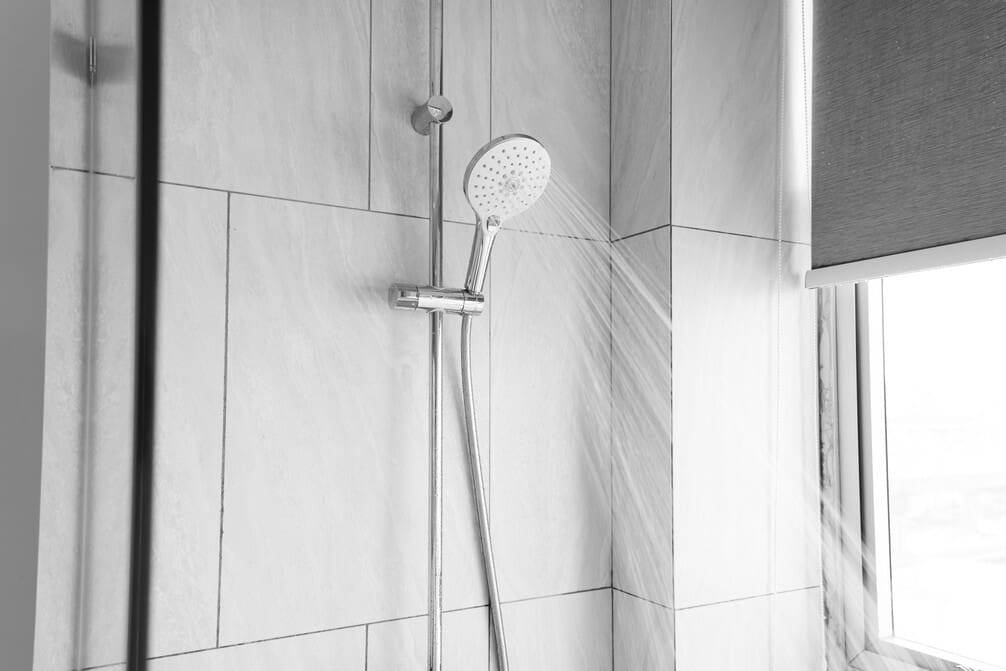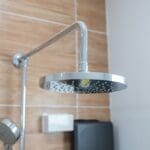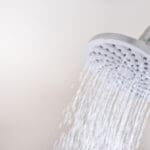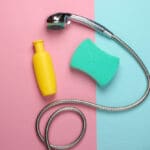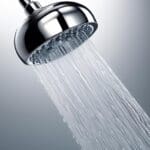Nearly 85% of households have hard water, a leading cause of buildup on brushed nickel shower heads, affecting their performance and appearance. If you’ve noticed a decrease in water pressure or unsightly deposits on your shower head, it’s likely time for a thorough cleaning.
By following four straightforward steps, you can restore your brushed nickel shower head to its original luster and efficiency without the need for harsh chemicals or professional help. First, you’ll need to gather some basic cleaning supplies, then remove and inspect your shower head.
Key Takeaways
- Regular cleaning of a brushed nickel shower head maintains its efficiency and appearance.
- Soap is a natural and effective cleaning agent for removing hard water deposits.
- Soaking the shower head in soap breaks down buildup and improves water flow.
- Gently scrubbing the shower head and reattaching it ensures a clean and functional result.
Gather Your Cleaning Supplies
Before you begin the process of cleaning your brushed nickel shower head, you’ll need to gather a few essential supplies: soap, a plastic food storage bag, a rubber band or twist tie, an old toothbrush, and a microfiber cloth.
Soap is a powerful, natural cleaning agent that’s perfect for tackling hard water deposits and grime without damaging the brushed nickel finish.
To effectively clean your shower, start by filling the plastic bag with soap. This soap will serve as your main cleaning solution, ideal for a shower head soak that loosens buildup. Carefully secure the bag around the shower head using the rubber band or twist tie, ensuring it’s submerged in the soap. Let it soak for at least an hour to break down the hard water deposits.
After soaking, use the old toothbrush to gently scrub away any remaining residue, paying special attention to the nozzles. It’s crucial to avoid using abrasive materials or cleaners, as they can scratch or tarnish the brushed nickel finish.
Remove and Inspect the Shower Head
After soaking and cleaning your shower head with soap, it’s essential to remove and inspect it for any further signs of damage or clogs. Turn off the water supply to ensure no water runs while you’re working. Carefully unscrew the shower head from the shower arm using pliers or an adjustable wrench. This step is crucial to avoid any damage to the brushed nickel finish.
Once you’ve managed to remove the shower head, it’s time to inspect it closely. Look for any signs of damage or clogs that could affect water flow or the overall appearance of the nickel finish.
Cleaning any visible mineral deposits or debris is next. Use a toothbrush or a small brush for this task. These tools are gentle enough not to scratch the delicate nickel finish but effective in removing buildup.
Scrub Away Residue
Once your shower head has soaked in soap, it’s time to scrub away any remaining residue using a toothbrush or scrub brush for a thorough clean. For brushed nickel shower heads, it’s crucial to be gentle and careful to avoid damaging the finish. Mix a small amount of dish soap with water and apply it to the brush for extra cleaning power. This will help in breaking down the residue without the need for harsh cleaning chemicals, abrasive cleaners, or solvent-based cleaners that can harm the brushed nickel’s surface.
Scrub in circular motions to effectively remove any buildup. Be diligent, yet gentle, to ensure you don’t scratch or damage your shower head.
After you’ve scrubbed away the residue, rinse the shower head thoroughly with clean water to remove any soap and loosened grime. Finally, dry the shower head with a clean, damp cloth. This step is vital to prevent water marks and maintain the pristine look of your brushed nickel shower head.
Rinse and Reattach
Having thoroughly scrubbed and rinsed your brushed nickel shower head, it’s now crucial to reattach it properly to ensure optimal performance. The reattachment process is straightforward, but you need to be mindful to prevent any damage to the finish or the bathroom fitting itself. Here’s how to get it back in place for a clean, refreshing shower experience:
- Gently Dry the Shower Head: Before reattaching, use a soft, lint-free cloth to pat the shower head dry. This is important because excess water can cause spots.
- Inspect for Any Remaining Residue: Make sure there’s no cleaning solution or mineral deposits left. If any residue remains, rinse with warm water. Remember, hot water can sometimes damage the finish, so stick with warm.
- Reattach to the Shower Arm: Carefully screw the shower head back onto the shower arm. Ensure it’s secure but avoid overtightening, which can harm both the shower head and the stainless steel threading.
After these steps, turn on the water to check for leaks. If everything looks good, you’ve successfully cleaned and reattached your brushed nickel shower head. Enjoy your clean, sparkling bathroom fixture!
Frequently Asked Questions
How Do You Clean a Brushed Nickel Shower Head?
To clean your brushed nickel shower head, detach it and soak in soap for 30 minutes. Scrub with an old toothbrush, rinse, dry, and reattach. Regular cleaning prevents mineral buildup.
What’s the Best Way to Clean Brushed Nickel?
To clean brushed nickel, soak it in distilled soap for 30 minutes, then gently scrub off mineral deposits. Clear clogged holes with a paperclip, and consider a filter to reduce future deposits.
How Do You Clean a Brushed Nickel Faucet Head?
To clean your brushed nickel faucet head, detach it if possible, soak in soap for 30 minutes, then scrub off deposits. Clear clogged holes with a paperclip, and reattach with new tape for a seal.
How Do You Get Water Stains Out of Brushed Nickel?
To remove water stains from brushed nickel, you’ll need a gentle cleanser like soap. Simply apply it with a soft cloth, rub gently, then rinse and dry. It’s an easy, effective method to restore shine.

